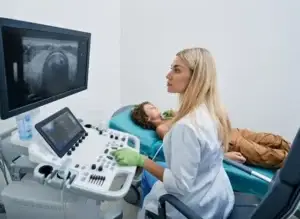Among the diseases that impact the lives of children around the world, Rotavirus is very common. Before the vaccine was developed, most children in the United States were infected with rotavirus by their fifth birthday. Rotavirus is a potentially deadly disease that kills roughly 500,000 children younger than five years old around the world each year.
What is Rotavirus?
Rotavirus, which is sometimes misspelled as Rotovirus, can infect humans as well as animals (e.g., monkeys, cows or sheep). It is the most likely cause of severe diarrhea in children each year. There are several strains of the viral infection, but only about five strains are commonly found in the United States. In non-tropical climates, infections are more likely to occur in the colder winter months than in the summer. Even though there is a vaccine for the disease, rotavirus still causes roughly 400,000 doctor visits for children each year. More than 200,000 children below the age of five visit the emergency room each year during the pre-vaccine period. As many as 50,000 to 60,000 children end up hospitalized due to severe dehydration. Rotavirus still accounts for roughly 20 – 60 deaths of young children each year. Rotavirus infections usually become milder with every infection (it is estimated that all children get repeat infections during the first few years of life).
Where does Rotavirus come from?
Severe diarrhea was not identified as a virus or a specific health condition for many centuries. The history of Rotavirus officially begins in 1943, when Jacob Light and Horace Hodes found that a filterable agent in the feces of children with infectious diarrhea also caused diarrhea in cattle. Prior to the 1970s, physicians were unable to treat infectious diarrhea effectively. As they could not identify the infectious agent that was causing the symptoms that they were seeing, they focused on rehydration as the primary treatment for the disease. In 1973, Ruth Bishop, Geoffrey Davidson, Ian Holmes, and Brian Ruck identified the viral cause of severe diarrhea and dehydration. The following year, Thomas Henry Flewett named the virus Rotavirus after the Latin word for “wheel” (rota), as the virus particle looks like a wheel under an electron microscope.
How is Rotavirus transmitted?
Rotavirus is a very contagious condition that is primarily transmitted via the fecal-oral route. The virus is found in the feces of the infected individual and is spread when hands or other parts of the body are contaminated with the virus. The virus can live for hours on hands and even longer on hard surfaces. Once children touch their feces and then put their hands in their mouth, they are exposed to the virus and eventually get sick. In most cases, it will take roughly two days for symptoms of rotavirus to develop. Rotavirus typically occurs in children ages 3 months to 35 months old. Furthermore, children can spread rotavirus both before and after they become sick with diarrhea. They can sometimes pass the virus to other members of the family and close contacts, and cause diarrhea in adults. Rotavirus infections can be significantly reduced by frequent hand washing.
What are Rotavirus symptoms?
Rotavirus symptoms are easy for parents and caregivers to recognize in small children. Around two days after a child is exposed to the virus, the primary symptoms that will develop include fever, vomiting, abdominal pain, and diarrhea. These symptoms last for 3 – 8 days. Severe diarrhea is the most common symptom of the virus, but several symptoms can increase the risk of dehydration. Other rotavirus symptoms include lethargy or lack of response from children, extreme thirst due to dehydration, lack of tears when a child is crying, dry skin, and less urination than usual. The lack of energy and less frequent urination are signs of dehydration that develops as a result of vomiting and diarrhea. Parents should encourage children to drink plenty of water and fluids to replace the fluids that are lost.
What is the rotavirus vaccine?
While the first rotavirus vaccine, RotaShield, was licensed and recommended in 1998, it was withdrawn from its manufacturer a year later due to safety concerns. Nowadays, there are two versions of the rotavirus vaccine in the United States that were approved by the Food and Drug Administration: RotaTeq and Rotarix. Both vaccines are given to children orally and the dosage that is recommended depends on the particular vaccine that is given to a child. The vaccines are made with different strains of the virus. The Rotarix vaccine has been used since 2008 and is made with live attenuated human rotavirus strains. Infants should receive two doses of this vaccine—at 2 months and 4 months of age. The RotaTeq vaccine has been used since 2006 and is made with a hybrid strain that is a reassortment of human-bovine strains. Infants should receive three doses of this vaccine—at 2 months, 4 months, and 6 months of age. The rotavirus vaccine effectiveness ranges from 85% – 95 % in vaccinated infants and young children.
What are the Rotavirus vaccine side effects?
When a child is given the rotavirus vaccine, certain side effects may develop. In most cases, rotavirus vaccine side effects are mild. The most common side effects of the vaccine include mild fevers, diarrhea, fussiness (particularly in infants and very young children), and vomiting. In most cases, the side effects will pass quickly. Even though the common side effects are generally mild, some severe side effects are cause for concern. If a parent notices blood in an infant or child’s stool, the child is acting weak, vomiting continues or severe stomach pain develops and results in severe crying, parents should seek medical advice. Intussusception (the sliding of one intestine into another) occurs in 0 – 4 cases of 100,000 vaccinated infants. A doctor should be informed that the child has recently been given the rotavirus vaccine, especially if it occurs within one week of taking the vaccine.
Who should not get the Rotavirus vaccine?
The rotavirus vaccine is not appropriate for every child. Any child who has an allergic reaction to a previous dose of the vaccine should not take future doses. Furthermore, a child who is allergic to any ingredient or component of the oral vaccine should not take it. The vaccine is not recommended for any children who are immunocompromised. If a doctor has suggested that a child has an abnormal digestive system, then the Rotavirus vaccine is not recommended.
Sources
http://www.cdc.gov/rotavirus/index.html
http://www.cdc.gov/rotavirus/about/symptoms.html
http://www.nvic.org/vaccines-and-diseases/Rotavirus.aspx
http://www.cdc.gov/vaccines/vpd-vac/rotavirus/fs-parents.html
http://www.cdc.gov/rotavirus/about/transmission.html
http://www.ncbi.nlm.nih.gov/pubmed/19799704
http://www.cdc.gov/vaccines/vpd-vac/rotavirus/Vac-label-parents.htm
http://www.historyofvaccines.org/content/articles/rotavirus



